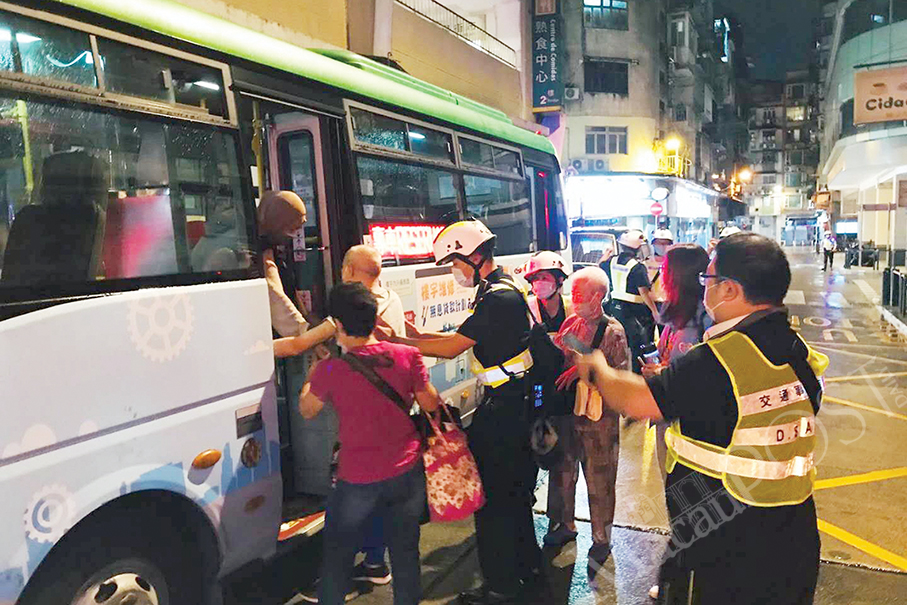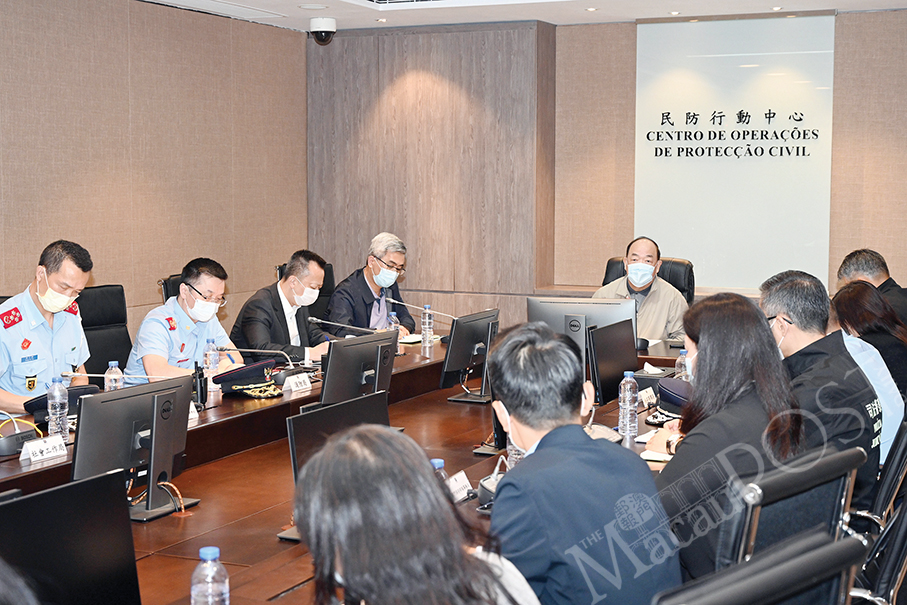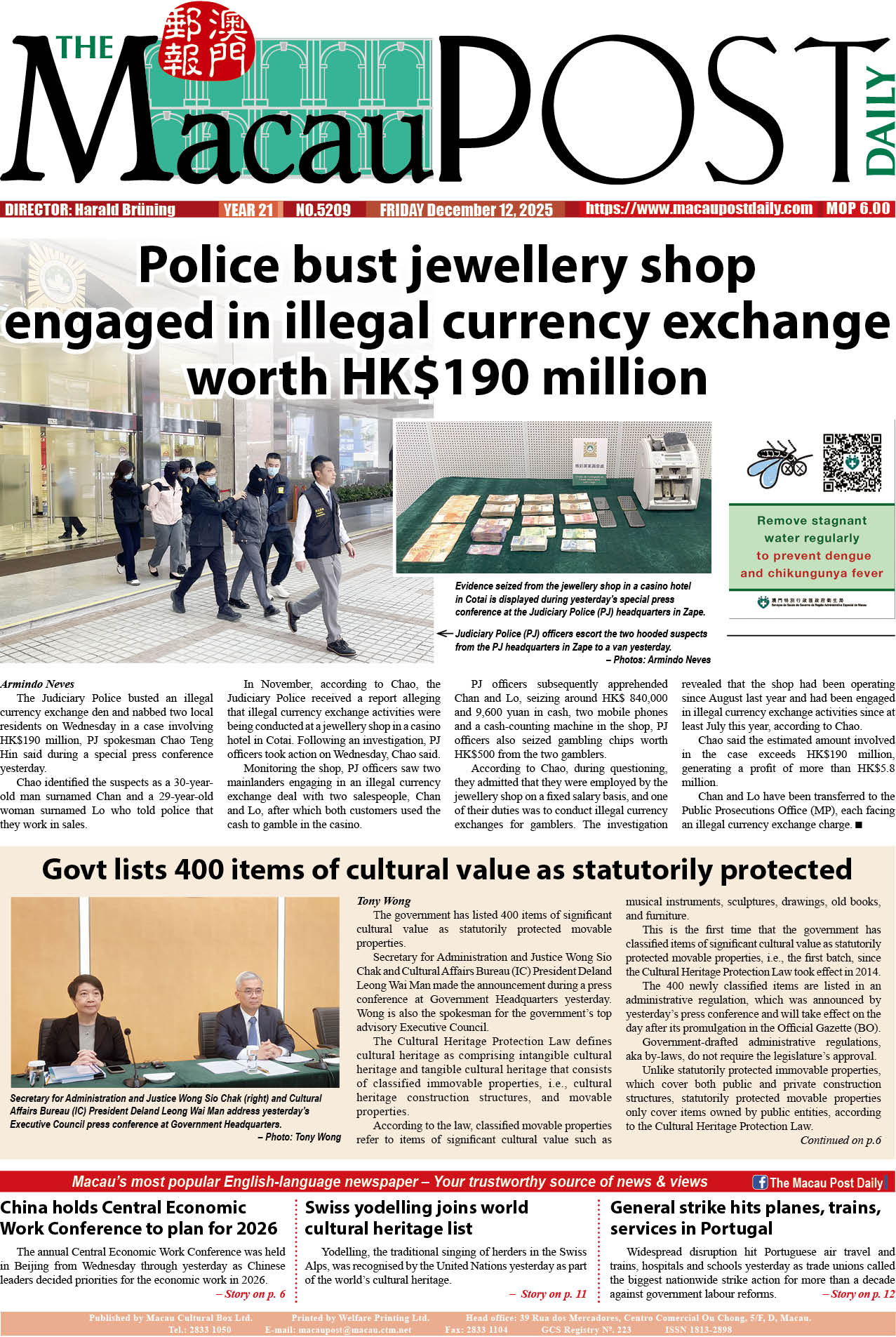Floods less severe than forecast, residents find Higos ‘scarily noisy’
Macau hoisted signal No. 10 – its highest typhoon warning signal – for the first time this year in the early hours of yesterday as Typhoon Higos heading towards Guangdong was moving close to Macau, toppling many trees across the city and causing up to 0.8-metre-high floods in the Inner Harbour area.
Chief Executive Ho Iat Seng personally oversaw the government’s civil protection operations which involved Macau’s various public security forces between Tuesday night and yesterday morning. Secretary for Security Wong Sio Chak coordinated the operations.
The Meteorological and Geophysical Bureau (SMG) hoisted signal No. 10 at 5 a.m., when Higos was located just 30 kilometres south-west of Macau, before lowering the signal to No. 8 at 7:30 a.m. yesterday.
Higos reached a wind speed of up to 215 km/h, with an average speed of 130 km/h, according to the weather bureau.
Macau escaped major damage and serious injuries during Typhoon Hato even though the signal No. 10 remained hoisted for 2 ½ hours.
Residents told The Macau Post Daily yesterday that they found Typhoon Higos “scarily noisy” but “less destructive” than other signal No. 10 typhoons in the past.
Residents said that while they didn’t notice major damage they still found Higos “very scary” and “very noisy”. They praised the weather station and civil protection authorities for their constant flow of information about the typhoon. “I was quite scared because Higos was so noisy – bangs, rattles and even vibrations in our building,” Carl Leong, who lives in a high-rise in the Nam Van district, told The Macau Post Daily yesterday morning. Kim, a Taipa resident, said, “My whole building was awake because of the sound of shattering glass,” adding that she found the noise generated by Higos both “scary and nerve-wrecking”.
After the weather bureau first hoisted signal No. 8 at 11:30 p.m. on Tuesday, it raised the signal to No. 9 at 2:30 a.m. yesterday, when the lower enclosed deck of Sai Van Bridge was closed to traffic so that the only remaining way of travelling between the peninsula and Taipa was suspended. Sai Van Bridge’s lower enclosed deck was reopened to traffic at 7:30 a.m. yesterday, when signal No. 10 was replaced by signal No. 8.
After Higos had passed Macau, the weather station lowered the signal to No. 3 at 11:30 a.m. yesterday, when the city’s public bus service was resumed and the three Macau-Taipa bridges were reopened to traffic.
All typhoon warning signals were lowered at 3:30 p.m. yesterday.
The three Macau-Taipa bridges – Old Bridge, Friendship Bridge and Sai Van Bridge – are customarily closed to traffic after signal No. 8 has been hoisted, when Sai Van Bridge’s lower enclosed deck is opened, serving as the only remaining way for vehicular traffic between the peninsula and Taipa. If the storm warning signal is raised to No. 9 or above, the enclosed deck is normally closed as well.
First signal No. 10 since Sept 2018
Macau did not hoist the signal No. 10 last year, after hoisting it in August 2017 and September 2018 for Super Typhoons Hato and Mangkhut respectively. The former killed 10 people and injured over 200, while the latter caused several dozen injuries.
The observatory said yesterday that Typhoon Higos was stronger than Mangkhut in 2018, and its strength was just below Hato’s in 2017.
Higos made landfall in Zhuhai’s Jinwan district at 6 a.m. yesterday, when it was located only 20 kilometres south-west of Macau.
The weather bureau issued the third level of a storm surge warning (“orange”) at 8:30 p.m. on Tuesday – indicating that the flood level was forecast to reach between 1 metre and 1.5 metres above the road level in the Inner Harbour area, before raising the storm surge warning to the fourth level (“red”) at 5:30 a.m. yesterday – indicating that the flood level was forecast to reach between 1.5 metres and 2.5 metres.
When Higos pummelled Macau in the early hours of yesterday, the Inner Harbour area was hit by floods of up to 0.8 metres. The flooding gradually subsided yesterday morning before the weather bureau removed all storm surge warning signals at 11:30 a.m., when signal No. 8 was replaced by signal No. 3.
The Municipal Affairs Bureau (IAM) said in a statement yesterday that after signal No. 10 was replaced by signal No. 8, it was deploying staff members to remove the “large” number of toppled trees across the city.
The civil protection authorities announced yesterday morning that Typhoon Higos caused 15 injuries – 14 men and 1 woman, 12 of whom sustained “minor” injuries, while three sustained “moderate” injuries, according to the international Injury Severity Score (ISS).
The Civil Protection Operations Centre (COPC) reported 274 incidents caused by Typhoon Higos, such as toppled trees, damaged electricity cables, sign boards, windows, and scaffolding.
The weather bureau noted on Tuesday that Higos was moving closer to Macau than previously forecast.
After their closure on Tuesday night following the issuing of the orange storm surge warning, the 20 public car parks in the city’s low-lying areas reopened at 11:30 a.m. yesterday when all storm surge warning signals were removed.
Border checkpoints closed
The new Macau-Zhuhai joint checkpoint on Hengqin Island, along with the Lotus Flower Bridge, and the Hong Kong-Zhuhai-Macau Bridge were closed after the Macau Meteorological and Geophysical Bureau hoisted the signal No. 8 on Tuesday night. At 6 a.m. yesterday, all Macau-Zhuhai land border checkpoints were closed during Higos’ onslaught. The Barrier Gate checkpoint and the Zhuhai Macau Cross-border Industrial Zone checkpoint in Ilha Verde reopened at 10 a.m. yesterday. The Macau government said yesterday morning that it would need to discuss with its Zhuhai counterpart the time when the Hengqin checkpoint will reopen as some glass panelling on the building was damaged by Higos.
The Hong Kong-Zhuhai-Macau Bridge reopened at 2 p.m. yesterday when the Golden Bus service also resumed.
The government launched its storm surge evacuation plan for residents in the city’s low-lying areas on Tuesday night as it forecast that serious flooding would hit the areas yesterday in the wake of the impact of Typhoon Higos and a storm surge.
The Civil Protection Operations Centre said yesterday that 2,722 residents in low-lying areas were evacuated to safe locations. The city’s 17 emergency shelters recorded 192 people during the typhoon, comprising 93 Macau residents, 80 mainland visitors, three Hong Kong visitors, and 16 visitors from elsewhere.
Meanwhile, animal protection association ANIMA said a statement on its Facebook page yesterday that Typhoon Higos had left its shelter in Coloane in a “terrible situation”. ANIMA spokeswoman Zoe Tang Wing-yan told public broadcaster TDM that the repairs would possibly cost 400,000 patacas.

Macau Customs Service officers assist residents to get on a bus while being evacuated from their homes in the city’s low-lying areas on Tuesday night. Photo: GCS
Pedestrians walk past trees toppled by Typhoon Higos in Avenida D. João yesterday morning. Iong Tat Choi

Chief Executive Ho Iat Seng (centre) chairs a meeting by the Civil Protection Operations Centre (COPC) attended by senior officials including Secretary for Security Wong Sio Chak (fourth from left) yesterday to coordinate the government’s anti-Typhoon Higos measures. Photo: GCS







